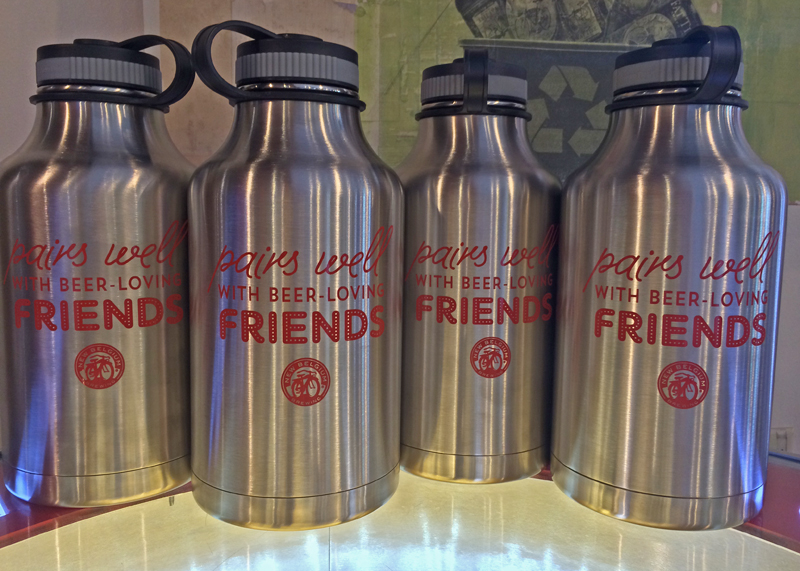Beer Growlers: Beyond the Basics
Advanced Materials, Filling Stations and Better Practices
Growlers, even the best ones, are imperfect versions of what we’d like them to be. Taking draft beer, transferring it to a portable container, and having the sensory experience of that beer stay the same after some distance and time are involved. … Well, it’s a perilous trip.
Voicing the limitations of growlers isn’t particularly new (Brooklyn Brewery’s Garrett Oliver did a thorough job stirring the pot a few years back, for example). Even the great food writer M.F.K. Fisher, who wrote sparingly about the subject, appreciated the limits of moving draft beer from its original place. “Beer in big cities,” she wrote in How to Cook a Wolf (1942), “can be sent out for in a bucket to the corner pub, even from Park Avenue, but probably even on Park Avenues, in New York or elsewhere, it is better in bottles.” (Buckets = early growlers.)
The core challenges haven’t changed too much. Exposure to oxygen degrades beer. So does sunlight (that delightful je ne sais skunk). Carbonation will depart if the beer isn’t kept inside a sealed, pressure-safe container. Temperature shifts tend to be unflattering. And outside yeast and bacteria would love nothing more than to chow down on whatever sugar’s left in there.
An ideal growling solution would protect one’s beer from all of these things and others. And we’re at least getting closer to that—addressing the limits of traditional brown glass beer growlers and aiming for the less imperfect stability found in bottles and cans. Recent years have had a wealth of new growler designs, retailer options, and legislative changes. More are on the way.
Fill ‘Er Up?
Perhaps the most noticeable shift over the past few years is via all of the new materials used for beer growlers, and their accompanying accessories. Beyond the typical 64oz glass growler, the options (some better than others) now include flexible pouches with names like EcoGrowler and The BeerPouch, unbreakable and BPA-free plastic growlers, beautiful ceramic ones, and plenty of stainless-steel varieties. The lattermost have probably had the most visible impact, involving various shiny, robustly designed growlers like The Bräuler, Miir, and Drink Tanks.
Hydro Flask’s heavily insulated design (for instance) promises to keep beer cold for up to 24 hours. “Extended life caps,” which allow one to introduce a protective blanket of carbon dioxide into a growler (instead of bringing in oxygen from the outside air), serve to lessen oxidative effects. (“The Growler Apocalypse” by Mike Stuart offers a good rundown of recent carbon dioxide systems.)
There are tradeoffs to all of these solutions. Compressibility tends to compromise sturdiness and insulation. Space-age-iness tends to be inversely proportional to one’s ability to get some breweries to fill the thing. Lightproof generally means no ability to see the fill level. Features cost money. Even using extended-life caps, oxygen is still all up in your business during fills.
But many also offer significant improvements over glass. Less light exposure. Less carbon dioxide loss during filling. Durability approaching unbreakable. Add-on options, such as the GrowlerSuit (and similar cycling-jersey-for-your-growler-like options), can better protect existing growlers from light and temperature fluctuations. Newer concepts like Synek Draft System, which will employ pressure-rated disposable pouches initially empty of air, could help fix oxygen issues. As one further option, breweries like Oskar Blues Brewery and (more recently) Cigar City Brewing have begun using the Crowler, a 32-ounce can that’s purged, filled immediately, and sealed atop the bar.
For the individual: it’s a matter of whatever matters most, and people will even tend to have quite different thresholds as far as perceiving effects like oxidation, skunking, etc. Your mileage may vary.
The retail landscape of growlers has also shifted, with dedicated growler-filling stations being perhaps the most widespread development. Alfred Gruber GmbH manufactures some larger growler-filling systems (with up to 20 taps) for brewers like Victory and Sierra Nevada (watch a short video of the system), while The Growler Station (1–4 taps) has made major inroads with both brewery and retailer sides.

Beer pours into a growler in an Alfred Gruber GmbH filling station at the Sierra Nevada Torpedo Room in Berkeley, Calif. Photo by Jon Page.
Both systems use a counter-pressure approach that allows growlers to be purged of air using carbon dioxide before the filling process begins—evacuating the vast majority of oxygen and essentially mimicking a bottling line (for the most part). A representative indicated a shelf life of 30–45 days for growlers filled via The Growler Station, suggesting significant improvements over a typical fill. A notable compromise is that such systems only work with a limited subset of the above-mentioned growlers (no stainless steel ones in The Growler Station, for example, since the operator can’t see how full they are). And not everyone will have a local retailer with one.


All good points regarding purging oxygen, retaining CO2 and even temperatures but…what about cleaning and purging moisture so that bacteria doesn’t grow as an empty growler awaits its return to a filling station?
I invented the “Growler Collar” to solve the problem of ‘funky’ growlers being returned for refilling. The 5″ disc threads onto the top of 64 and 32oz clear or amber glass growlers and the new PET growlers of the same sizes. Three little feet elevate the growler off a counter for draining after a thorough rinsing with hot water…you can see when the growler is dry, usually ovenight (depending on humidity), that’s when the cap goes back on sealing the clean and dry growler for refilling when needed.
Growlers always have the logo/branding on them and Growler Collars can be custom imprinted as well and retail for $10. Patented and Made in the USA…just like your favorite craft beverage. Bottoms UP!
Staton Lorenz
http://www.growlercollar.com